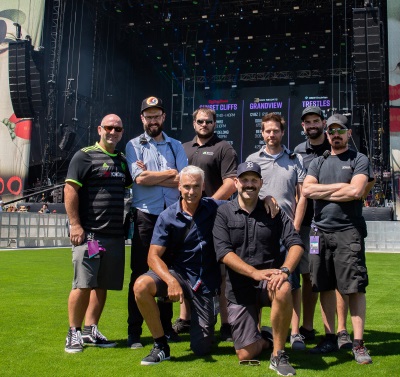
PSW: What are the key issues involved in monitoring sound levels and verifying noise limit compliance in the community and FOH limits on-site?
PV: Assuming that there is a commonly agreed upon set of community noise thresholds and measurement locations, monitoring and reporting follows standardized measurement and reporting processes, which run rather smoothly. There is potential for confusion if there has been inadequate communication of margins of error, for example due to equipment and noise signal type. This can be prevented by explicitly addressing this issue in advance – as always, good communication with all parties is key.
On the other hand, often the noise ordinance may require interpretation and clarification by the acousticians involved, to adjust unrealistic expectations such as setting noise thresholds below ambient noise. This is a crucial and strategic step in the process, as diverging interests among the key stakeholders such as promoters, venues, and cities may cause delays.
AD: Once ambient/baseline noise level estimations are set, and event noise measurement locations are agreed upon, monitoring locations should be placed as close as logistically possible to locations specified within the regulations. Our FOH SPL monitors allow for data logging, which gives additional weight to the limit and eliminates assessment ambiguity.
PV: Monitoring FOH level limit compliance follows analogous measurement standards and processes, only differing in the way data is communicated to the key stakeholders like sound engineers. For KAABOO, we place computer monitors near each stage’s FOH console, displaying real time and time averaged levels, and clearly flagging measured overages. Several early warning triggers give time to the engineers to gradually make the required corrections and to the noise abatement team to intervene, if needed.

PSW: What kind of response do you get from city officials and resident representatives as you are communicating to them the limits of noise mitigation efforts?
AD: I often find that city officials and neighborhood representatives will bring in their own acoustical consultants to help represent their goals. When this happens, communication among acousticians is generally delightfully clear and straightforward, as there is a consensus among scientists about the properties of sound.
We, in turn, need to make our own communication with community, city council, venue, event, and artist representatives as clear and straightforward as possible, in a way that helps non-specialists to understand the challenges and suggested solutions. One of our most important goals is to empower officials with the knowledge they need to make the right decision for their community, and to defend those decisions if/when they are confronted by upset residents.
PV: When the technical team successfully communicates specialized information to our non-expert project partners in a way that helps them to make solid decisions, we help to set a positive tone and support productive interactions towards a compromise that will best address the needs of all parties.
Challenges to smooth discussions tend to happen when expectations are ill defined or underlined by larger scale conflicts, which can sidetrack discussions. At the end of the day, noise mitigation expectations need to be addressed not in isolation but in the broader socioeconomic and implementation context of a given event.
SS: Exactly; it’s important to understand there can be a big difference between legal compliance and a satisfied community. It can be entirely possible to have one and not the other depending on a variety of factors, including time of day, type of music, disruption from things other than the sound system, etc. Helping city officials and resident representatives understand that not all noise from a festival is due to the sound system can go a long way to setting expectations.
PV: The success that we’ve experienced at KAABOO is largely due to honest and open discussions among all interested parties in which we were able to define noise ordinances and set contextually realistic expectations that honestly reflected each party’s specific interests. With this solid ground set, each party was prepared to compromise, and this is what enables KAABOO to continue being a profitable and enjoyable experience for everyone.
Carefully listening to and seriously addressing public concerns about noise go a long way towards earning the support of the cities surrounding festival venues, a necessary condition for music scenes to coexist and thrive alongside residential communities. At KAABOO, clearly communicating the range of issues involved in mitigating noise from large, outdoor music events and the extensive resources devoted to the task, paired with measured qualitative and quantitative improvements, has created an environment where the festival and the community proceed successfully as partners, hopefully for years to come.
